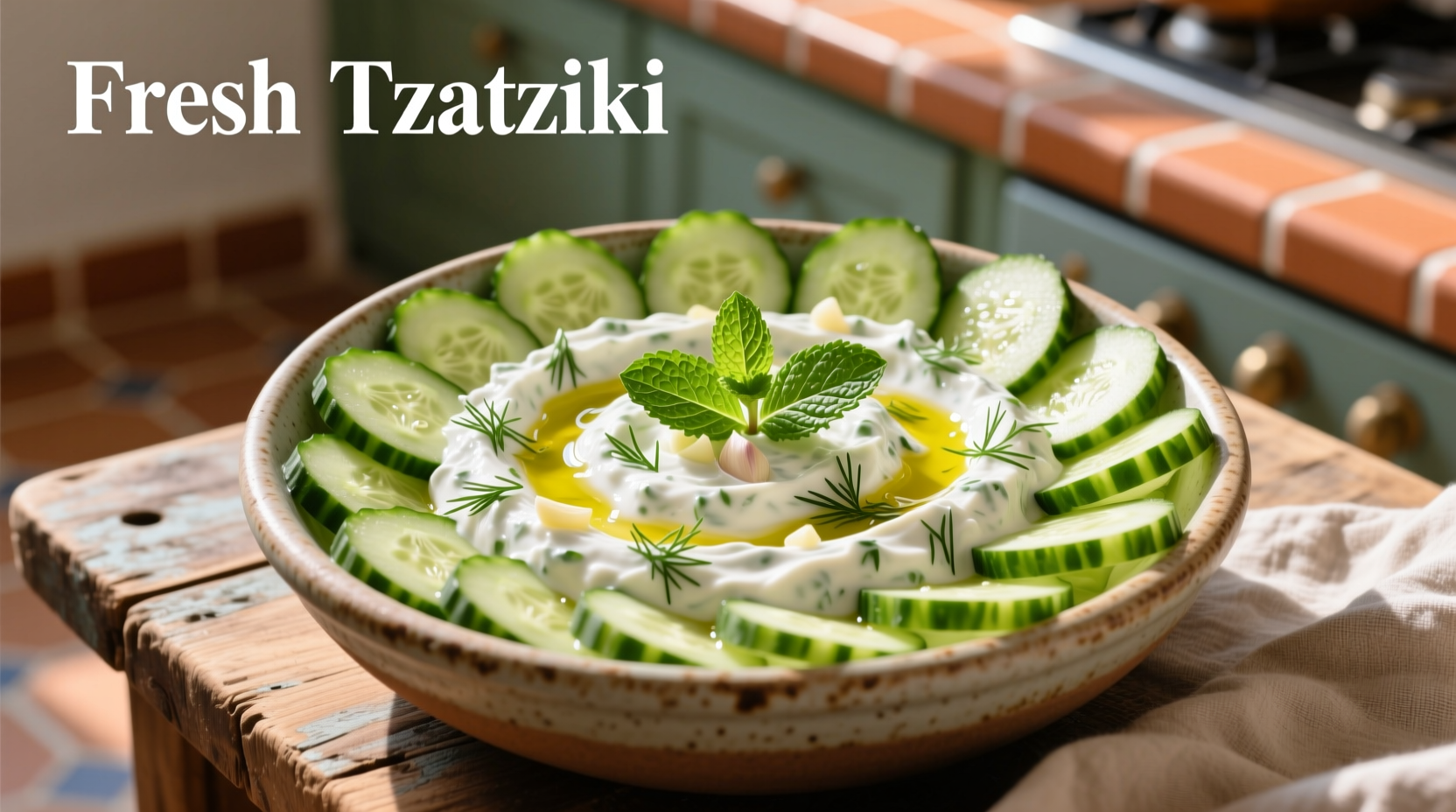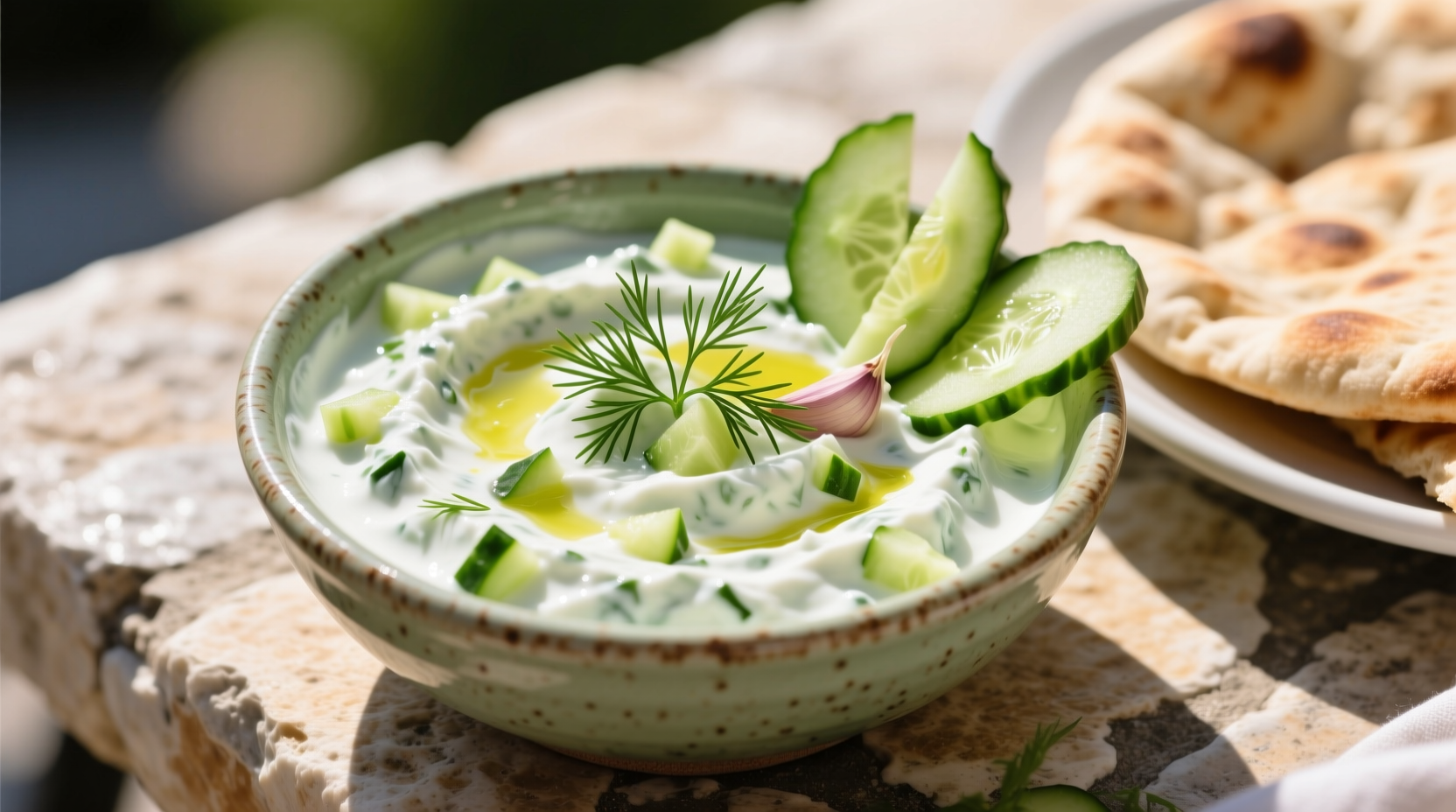If you've ever wondered what does tzatziki taste like, imagine the cool refreshment of cucumber meeting the creamy richness of strained yogurt, elevated by aromatic garlic and a hint of fresh dill. This traditional Greek sauce delivers a complex yet harmonious flavor profile that's simultaneously refreshing and savory—making it far more than just a simple dip.
The Core Flavor Components of Authentic Tzatziki
Understanding what tzatziki tastes like requires examining its essential ingredients and how they interact:
- Greek yogurt provides the creamy base with a pleasant tanginess from natural fermentation
- Grated cucumber (properly drained) adds refreshing coolness and subtle sweetness
- Fresh garlic contributes aromatic pungency that mellows as it sits
- Lemon juice or vinegar enhances the bright acidity
- Olive oil adds richness and carries flavor compounds
- Fresh herbs (typically dill or mint) provide aromatic complexity
When properly balanced, these elements create a sauce that's neither overwhelmingly garlicky nor excessively sour. The cooling effect of cucumber tempers the yogurt's natural tartness, while the olive oil rounds out the texture. This delicate equilibrium defines what authentic tzatziki tastes like compared to imitations.
Texture's Role in the Tzatziki Experience
The mouthfeel significantly influences how tzatziki tastes. Traditional preparation uses thick, strained Greek yogurt that provides substantial body without being heavy. The cucumber should be finely grated and thoroughly drained to prevent watery consistency. When executed properly, tzatziki offers a luxuriously smooth yet slightly textured experience that coats the palate evenly.
Texture missteps dramatically alter the taste perception. Watery tzatziki tastes diluted and one-dimensional, while overly thick versions can feel pasty and mask the delicate flavor balance. This explains why many commercial versions disappoint compared to homemade—answering the common question of why does store-bought tzatziki taste different.
Tzatziki Compared to Similar Sauces
| Sauce | Primary Base | Flavor Profile | Texture |
|---|---|---|---|
| Tzatziki | Greek yogurt | Cool, tangy, garlic-forward | Smooth with fine cucumber texture |
| Raita | Regular yogurt | Milder, sweeter, herb-focused | Thinner, more liquid |
| Ranch | Buttermilk/mayo | Rich, herbaceous, less acidic | Creamy, uniform |
| Tarator | Yogurt/walnut | Nutty, less tangy, earthy | Thicker, grainier |
This comparison clarifies what makes tzatziki unique in taste among similar cold sauces. While raita shares yogurt and cucumber elements, its milder profile and thinner texture create a distinctly different experience. The bright acidity and pronounced garlic notes set authentic tzatziki apart from the richer, less tangy ranch dressing.
Regional Variations That Alter Tzatziki Flavor
Understanding what tzatziki tastes like requires acknowledging regional differences. In Greece, tzatziki typically features dill and lemon juice, creating a brighter profile. Turkish cacık often includes more garlic and sometimes mint, yielding a sharper taste. Bulgarian tarator incorporates walnuts, adding earthiness that changes the flavor balance significantly.
These variations demonstrate how cultural context shapes expectations. As noted by the Oxford Handbook of Food History, Mediterranean condiments evolve with local agricultural practices and historical trade routes—explaining why tzatziki flavor varies across regions.
Perfect Pairings: Foods That Complement Tzatziki's Flavor
The refreshing quality of tzatziki makes it exceptionally versatile. It cuts through rich flavors while enhancing more delicate ones:
- Grilled meats (especially lamb and chicken)
- Falafel and other fried foods
- Fresh vegetable platters
- Pita bread and gyros
- As a sandwich spread
- With roasted potatoes
When served with grilled items, tzatziki's coolness balances charred flavors. With fried foods, its acidity cuts through richness. This versatility explains why understanding what tzatziki tastes like helps home cooks elevate everyday meals.
Crafting Authentic Tzatziki Flavor at Home
To achieve the characteristic tzatziki taste profile, follow these professional tips:
- Use full-fat Greek yogurt for optimal creaminess
- Thoroughly drain grated cucumber (squeeze in cheesecloth)
- Let garlic mellow by mixing with yogurt 30 minutes before serving
- Use fresh lemon juice rather than vinegar for brighter flavor
- Chill for at least 2 hours before serving to allow flavors to meld
These techniques address common pitfalls that alter tzatziki's taste. Many home cooks wonder why does my tzatziki taste sour—often because they skip the crucial draining step or use low-fat yogurt that separates.

Common Tzatziki Flavor Misconceptions
Several myths persist about tzatziki's taste profile:
- Myth: Tzatziki should be extremely garlicky
- Reality: Garlic should be present but balanced—never overpowering
- Myth: All tzatziki tastes sour
- Reality: Properly made tzatziki has balanced tang, not excessive sourness
- Myth: Tzatziki tastes like ranch dressing
- Reality: The dairy base creates similarity, but tzatziki's yogurt tang and cucumber freshness distinguish it
These clarifications help set accurate expectations for what tzatziki should taste like when properly prepared.
How Tzatziki's Flavor Changes Over Time
Freshly made tzatziki offers the most vibrant flavor profile, but proper storage affects taste development. When refrigerated in an airtight container:
- Day 1: Bright, distinct cucumber freshness
- Day 2-3: Flavors meld; garlic becomes more integrated
- Day 4+: Flavor intensifies but cucumber freshness diminishes
This evolution explains why many restaurants prepare tzatziki the day before service—answering the question of does tzatziki taste better the next day. For optimal flavor balance, consume within 3-4 days.
Final Thoughts on Tzatziki's Distinctive Taste
Understanding what tzatziki tastes like reveals why this sauce has endured for centuries across Mediterranean cultures. Its refreshing coolness, balanced tang, and subtle garlic notes create a versatile condiment that enhances rather than overwhelms. Whether you're sampling it for the first time or perfecting your homemade version, recognizing these flavor elements helps appreciate tzatziki's culinary significance beyond just another dip.











 浙公网安备
33010002000092号
浙公网安备
33010002000092号 浙B2-20120091-4
浙B2-20120091-4